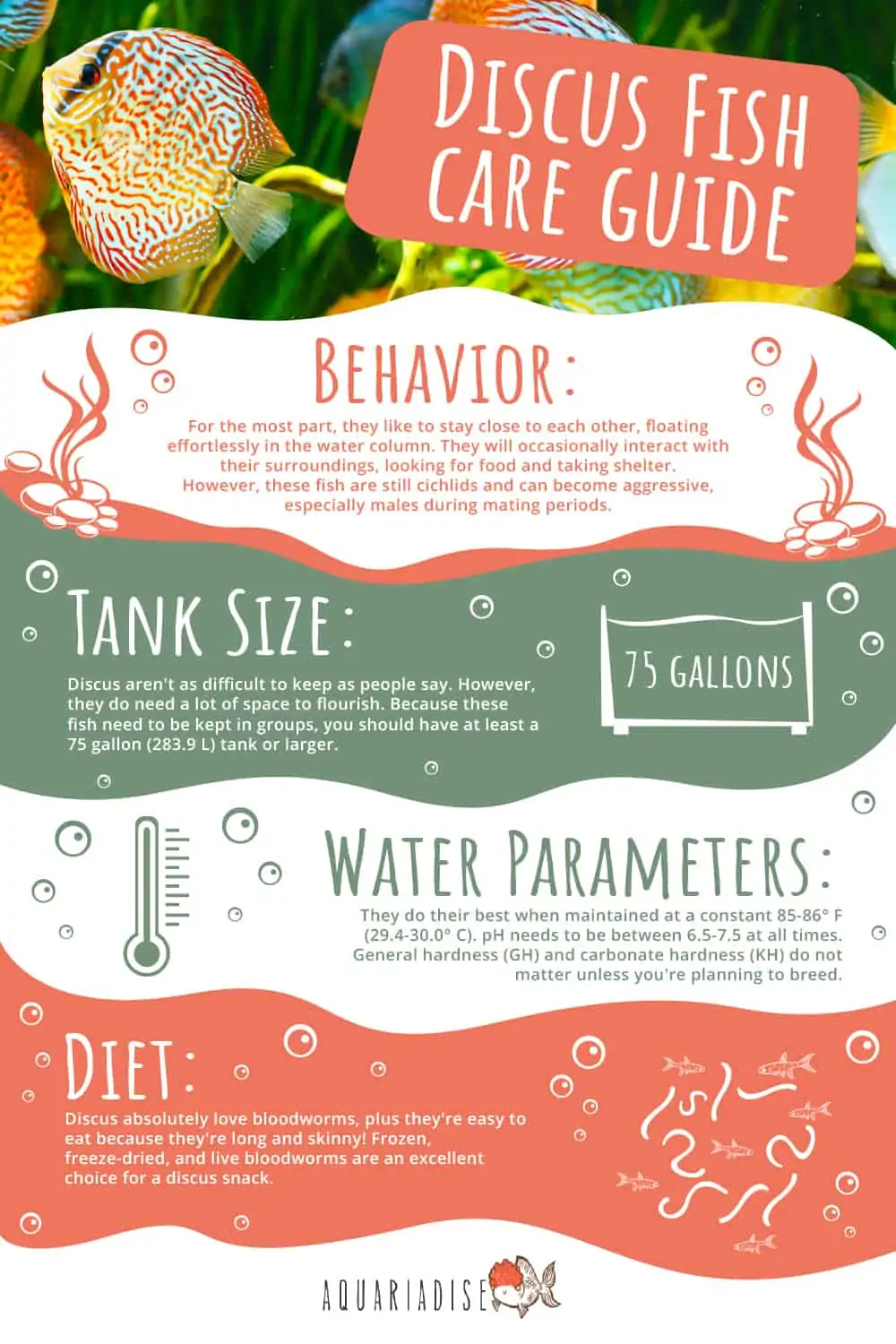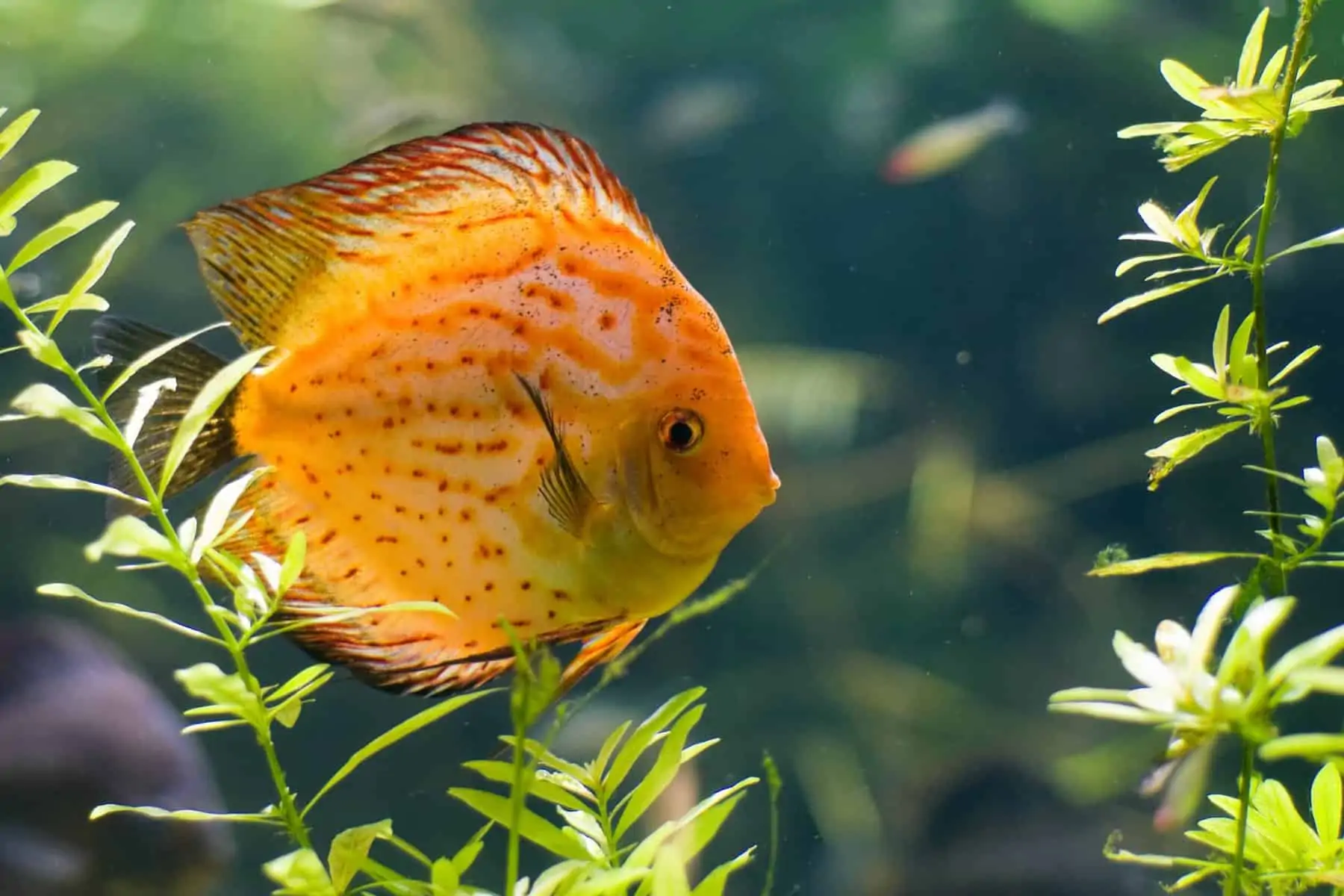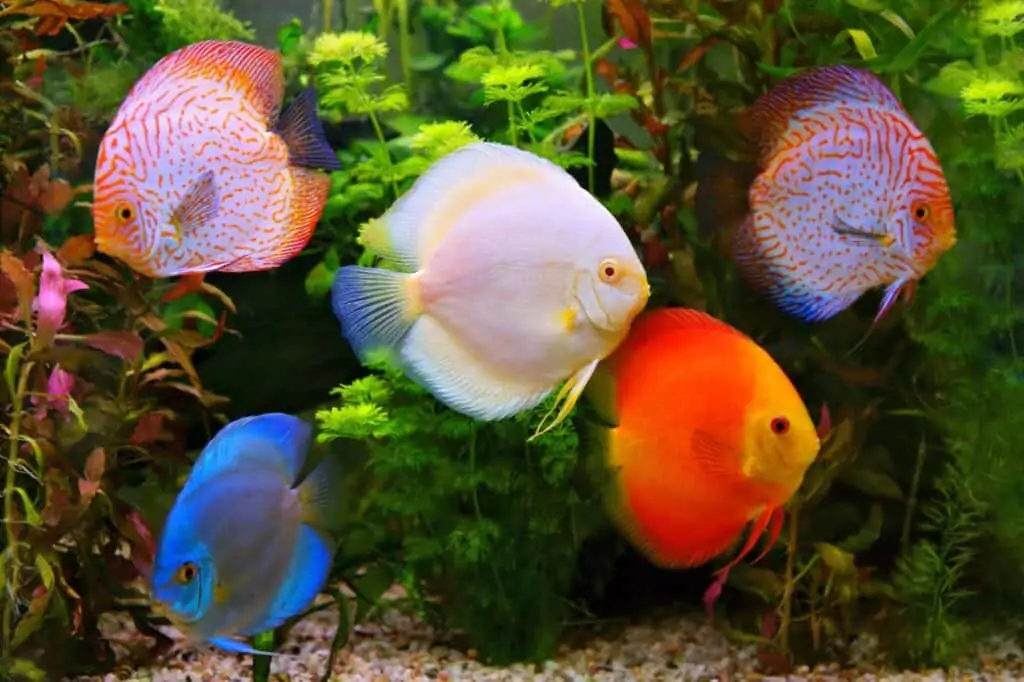Discus are some of the most beautiful fish available in the freshwater aquarium hobby. Still, they are also some of the most challenging.
With a little bit of research and the proper setup, anyone can have a stunning tank filled with discus. These fish need pristine water conditions and can be very expensive, so you will want to give them the best care possible!
Keep reading to find out everything you need to know about this popular aquarium fish and how to keep these challenging fish in your own aquarium!

Name
Discus (Symphysodon spp.) are named for their extended disc-like appearance. These fish range in shape and size and can be circular or triangular.
It is currently believed that there are 3-5 different species within the Symphysodon genus. The blue discus (Symphysodon aequifasciatus) and red discus (Symphysodon discus) are the most popular within the aquarium hobby.
Even though these fish aren’t generally referred to as cichlids, they are a part of the Cichlidae family.
Natural habitat
This article will mainly look at blue discus (Symphysodon aequifasciatus) and red discus (Symphysodon discus).
Blue discus are found in eastern parts of the Amazon River in South America. More specifically, they live in slow-moving tributaries east of where the Negro River meets the Solimões River.
They can be found in schools; during breeding season they can become more territorial and might be found in smaller numbers. They like to hide among the rocky substrate behind fallen branches and roots.
Red discus are also found in the Amazon River but are more concentrated in Brazil. These fish can be found at the mouth of the Negro River and in the lower regions of the Abacaxis and Trombetas Rivers.
While not much is known about their natural environments, we can assume that they prefer slower-moving waters with roots and vegetation, as blue discus do.
Identification
The main reason that discus are so popular in the aquarium hobby is due to their interesting body shapes and intense colorations. These fish have a particular pigmentation that makes them a beautiful centerpiece in the aquarium.
Many variations have been created by way of the industry, like pigeon blood discus, snow-white discus, and starburst discus. Their color intensity and patterns will further influence pricing.
One of the most common patterns to come across is checkerboard, where a contrasting color is mottled over another, making for a genuinely vibrant fish.
As their common names suggest, blue discus will have mostly blue bodies while red discus will have mostly red bodies.
It is not uncommon for a blue discus to have some red coloration or a red discus to have some blue coloration. Horizontal and vertical patterning will also vary across fish, and yellows, greens, and browns may be present.
Discus often have different colored eyes, which can be bright red, yellow, or brown.
How big does a discus fish get?

Both blue and red discus grow to be about 8 inches (20.3 cm) long and 8 inches high. These fish are laterally compressed, which makes them very tall instead of wide.
What is the lifespan of a discus fish?
Discus fish can live for a surprisingly long time. Many captive-bred fish can live to be 10-15 years old.
Sadly, not many discus make it to this age as they can be more challenging to keep than most other freshwater tropical fish.
But what makes discus so challenging to keep?
Discus tank requirements
Discus aren’t as difficult to keep as people say. However, they do need a lot of space to flourish.
Because these fish need to be kept in groups, you should have at least a 75 gallon (283.9 L) tank or larger.
Many hobbyists believe that these fish do best in a bare-bottom tank. They are easier to clean in order to keep water parameters stable.
They also recommended adding driftwood and potted plants, like Anubias spp., Java fern (Microsorum pteropus), and Amazon swords (Echinodorus amazonicus), that are able to withstand higher temperatures.
On the other hand, many hobbyists have great success with a sand substrate with planted species. As long as water quality is maintained and plants are chosen accordingly, there shouldn’t be much of a difference.
Are discus fish hard to keep?
Discus have a reputation for being very difficult to keep. This is because these fish tend to be extra sensitive to changes in water parameters, which many beginner hobbyists might not fully understand or be able to control.
Water parameters
Discus also need to be kept at higher water temperatures. They do their best when maintained at a constant 85-86° F (29.4-30.0° C); some hobbyists even like to keep them closer to 90° F (32.2° C), but this is the general ideal range.
pH needs to be between 6.5-7.5 at all times. General hardness (GH) and carbonate hardness (KH) do not matter unless you’re planning to breed.
To keep oxygen levels up in the aquarium, compensate with live plants and/or an air pump. Higher heat also means a faster metabolism and the need for more food and waste removal.
Water changes
Because discus need such exact water parameters, many hobbyists perform 50% water changes 2-3 times every week, especially in the first year of the fish’s life. This keeps your fish from becoming stunted, which will prevent it from reaching its impressive full size.
Of course, many hobbyists have gotten by with only performing one water change per week, but this is only recommended for expert discus-keepers.
Why do discus fish turn black?
While at first, a black discus might seem like just another rare coloration, this is actually a terrible sign that their health is in trouble.
Discus should only ever get more colorful over time; if they lose their colors, something is wrong.
A discus turning black is a sign of stress, sickness, bullying, or all of the above.
Stress
The first thing you will want to do is test your water parameters. If there are any unideal or unexpected results, start to perform 25% daily water changes.
Before bringing your discus home, it’s essential to check the water conditions where they are currently living. Too broad parameters swings can cause your discus to turn black or can even be fatal, and you will want to make acclimation as smooth as it can be.
Disease in discus
If water parameters aren’t the problem, then look for other signs of disease or illness. Discus can contract most tropical freshwater diseases, so be prepared with a quarantine tank and a variety of treatments.
Bullying
Lastly, check the behavior of the other fish in the tank. Are they healthy? Is your dark fish all alone hiding in a corner?
It’s possible that if all other fish are seemingly healthy in your tank that your fish is getting picked on. Remember that discus are cichlids, and some aggression is normal.
If possible, add more discus to the tank. This will help diffuse aggression. Otherwise, try to rearrange the tank and spread out food in different sections of the aquarium. With any luck, the aggression will die down on its own, and your fish will regain its color.
Discus tank mates
Discus are schooling fish and need to be kept in small groups. In a 75 gallon (283.9 L) tank, six discus is a good school with four females and two males.
Many hobbyists choose to keep their discus tanks species-only because maintaining water parameters can be hard enough. That doesn’t mean that keeping other fish with them is impossible, though.
The main things to keep in mind when picking tank mates are that discus are slow feeders and need higher water temperatures.
The perfect tank mate will withstand higher temperatures and stay out of the way during feeding times–preferably making little to no additional mess!
The most commonly kept discus tank mates are cardinal tetras (Paracheirodon axelrodi) and Sterbai corydoras (Corydoras sterbai). Some discus enthusiasts also have luck with angelfish (Pterophyllum spp.), but they can become territorial.
Discus behavior
Even though discus are beautiful to look at, sadly, they don’t have much personality. That doesn’t make discus any less interesting, though!
Discus are shy and calm fish. For the most part, they like to stay close to each other, floating effortlessly in the water column. They will occasionally interact with their surroundings, looking for food and taking shelter.
However, these fish are still cichlids and can become aggressive, especially males during mating periods.
Another important discus personality trait to note is that they are very picky eaters. This can become very frustrating as the health of your fish heavily relies on a good consistent diet. Uneaten food also needs to be cleaned, meaning even more tank maintenance.
The best way to overcome a picky discus is by leaving more time between feedings. Because their metabolism is faster in hotter water, you only need to wait a couple of days.
If your fish still refuses to eat, then you might need to try an assortment of other foods. If you find that your fish still only likes one food, though, don’t settle!
Keep trying and fasting until your discus are open to a large variety of foods.
Discus diet
Usually, discus are more than willing to eat as long as they have the right kinds of foods. These fish have tiny mouths, and their food should reflect that!
Discus absolutely love bloodworms, plus they’re easy to eat because they’re long and skinny! Frozen, freeze-dried, and live bloodworms are an excellent choice for a discus snack. However, they shouldn’t be the staple of the diet.
Instead, fill your fish’s main diet with beef heart, blackworms, and discus-specific granules. Remember to have a large variety on hand in case one day your fish decides that it hates everything you have to offer!
Breeding discus
Now, we get to the hard part. Breeding discus is seen as one of the most fulfilling freshwater aquarium hobbies. These fish are also incredibly profitable, making it even more worthwhile.
Getting a breeding pair

The first thing to do is acquire a breeding pair. This is easier said than done as these fish do not display sexual dimorphism and not all males and females are compatible. You can’t tell them apart and they might fight!
The best way to get a breeding pair is to buy 6-8 juveniles and let them grow up and pair naturally in your tank.
If you are limited on time, then it would probably be better to purchase an already-paired male and female, though this can also take a long time.
Setting up the tank
You will need to separate this pair from the rest of the fish in the tank into their own aquarium for best results
This tank doesn’t need to be excessively large but should be about 30-40 gallons (113.6-151 .4 L). The tank sides should be covered up so that your fish aren’t distracted by outside shapes and colors, especially if placing multiple tanks next to each other.
For a discus breeding tank, bare-bottom and minimal decorations are usually preferred to keep detritus from getting caught. You will also want to make it as easy as possible for the fry to find the parents.
Some breeders leave a vertical breeding tube or cone in the tank as discus will lay eggs on the sides of objects instead of on the bottom. However, this isn’t necessary, and your fish may just lay eggs on the aquarium glass instead.
Otherwise, the only things that need to be in the tank are a sponge filter and aquarium heater.
Water parameters and maintenance
If you’re able to keep discus happy in a display tank, then you won’t have to worry about water parameters too much when setting up a breeding tank.
As always, stability is better than perfection. Whatever conditions you have been keeping your fish in typically should not be changed just for breeding purposes, including water temperatures.
Water changes should still be done several times throughout the week to maintain water quality.
However, if breeding wild discus, then you will have to be very careful and particular with water parameters and maintenance.
Trouble breeding?
Sometimes, even if conditions are perfect, your discus will refuse to lay eggs. This can be very frustrating and leave you wondering what you’re doing wrong.
Funnily enough, the problem here is that things are probably too consistent. In the wild, most fish species depend on changes in environmental conditions, like more frequent rainfall or warmer temperatures, to begin spawning. It’s no different in the aquarium hobby.
If you’re experiencing this, try exchanging water changes with warmer water, changing scenery in the tank, and even moving the fish into a new aquarium setup.
Overall, remember to have patience. You will have to wait for your fish to mature and then to pair. Luckily, once paired, they will usually stay together for life.
Even if buying an already-paired couple, it can still take a few years for them to breed in your tank’s conditions.
Trouble with successful breeding?
One of the main problems aquarium hobbyists run into is their adult discus eating their eggs and fry.
This can be hard to avoid and the only way to succeed is to keep allowing the pair to breed. Eventually, they will let the eggs and fry grow up.
If your eggs don’t seem to be hatching at all, you might have mistaken your male and female pair for a female and female pair. What might seem like a fertile female might actually be two fish that are laying eggs at different times.
Hatching eggs and raising fry
Once the eggs have been laid, it will take 2-3 days for them to hatch. Unlike other freshwater species, discus fry are not free-swimming, and instead, they will attach themselves to a surface; the parents may move them around the tank during this time.
The fry will then detach from the wall and begin to swarm around the adult discus; during this time, they feed off the mucus of the adults, so no additional feeding is necessary yet.
At around three weeks, the fry will begin to eat small solid foods. At this point, you can remove the fry from the tank. When ready, the adult pair will continue laying more eggs.
After two months, the discus fry will accept larger foods. The amount that you feed and the quality of the water maintained will significantly affect the growth rate of the fry.
Once the fish have reached a considerable size, they can then be sold or moved to the display aquarium.
Why are discus fish so expensive?
As you can see, breeding discus is a full-time job. Daily water changes, several feedings a day, and finding the perfect adult pair can take years to do right. As a result, each fish ends up costing at least $40.
You should note that you should buy all your discus together at one time. This will prevent some fish from becoming larger than others and ensure they are all coming from the same water parameters.
Otherwise, look for bright coloration, clear eyes, and alertness. It would also be a good idea to ask to see them eat.
Conclusion
Discus are one of the most challenging and rewarding fish species to keep in the freshwater aquarium hobby.
These beautiful fish need higher water temperatures and near-daily water changes. Still, they can bring color to the aquarium, unlike any other species.
If you have any questions about discus, other species originating from the Amazon River, or have had experience raising your own discus fry, don’t hesitate to leave a comment below!


